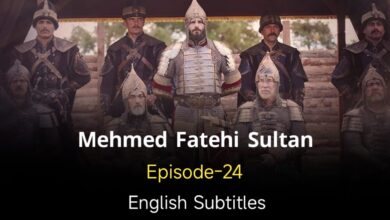Life of Sultan Mehmed

Real Life of Sultan Mehmed
Sultan Muhammad Al-Fatih: He is known as Muhammad Fatih i.e. Muhammad the Conqueror. He was the Ottoman sultan for a short period from August 1444 to September 1446. Then in February 1451, he again became a member of the Masanad. In the second term he was in power till May 1481. He and his Shaykh Aq Shamsuddin found the grave of Companion Abu Ayyub Ansari near Constantinople during the First Battle of Constantinople and later built a mosque there. Muhammad’s (pbuh) prophecy The conquest of Constantinople was conquered by the Ottoman Sultan Muhammad II at the age of 21.
His extraordinary ability to carry the largest cannons and ships across the land division at that time was one of the achievements of the Battle of Constantinople. This led to the fall of the Eastern Roman Empire. This Sultan Muhammad continued his European expeditions to Anatolia, Albania, Bosnia, Crimea, Italy. Sultan Muhammad is revered as a hero in modern Türkiye and the Muslim world. The Fatih district of Istanbul, the Fatih Sultan Muhammad Bridge and the Fatih Mosque are named in his memory.
Name Birth and Genealogy: Dynasty:- Ottoman dynasty. Name is Mehmed. Father Murad II. Mata Huma Hatun. Religion is Sunni Muslim. Born on March 30, 1432. He was Quran Hafez. He acquired all necessary skills in divination, taxation, Islamic jurisprudence, arithmetic, astronomy and warfare. He also learned Arabic, Persian, Latin and Greek. Consorts of this valiant and courageous Sultan were: Emine Gulbahar Hatun, Gulshah Hatun. Sittishah Khatun, Chichek Khatun, Khadija Khatun.
Strong promise of gaining power and victory: Muhammad al-Fatih became Sultan after the death of his father Sultan Murad II on 7 February 1451. took over the Ottoman Empire. He was a strong young man of twenty years. Very energetic and ambitious. He was concerned about conquering Constantinople, which was the capital of the Byzantine Empire. The dream of conquering Constantinople so overwhelmed him that he hardly talked to anyone about anything other than the conquest of Constantinople. He would not even allow anyone sitting with him to speak except in expected victory.
Siege of Constantinople through the ages: The victory of the ancient Turkish city of Kustuntunya was predicted by the Holy Prophet. So Muslims were very eager and enthusiastic to conquer it. The famous Companion Hazrat Abu Ayub Ansari RA was one of them. Kustuntunya still carries its sacred memory. He fell ill during the first campaign in Kustuntiniya in 51 AH and was buried there.
The details of the event are as follows: The famous city of ancient history is remembered in the history of Islam as the capital of the Ottoman Turkish Caliphate known as Constantinople of the Europeans and Kustuntinia “Istanbul” of the Muslims. The Messenger of Allah (PBUH) prophesied about this city in front of the Companions: “You will surely conquer Kustuntiniya. So how good will be his ruler and how good will be his victorious soldiers! (Musnad Ahmad).
In order to gain the good fortune of Kustuntuniya victory, the campaign was dreamed of since the time of Khulafay Rashedin, but in 49/669 Hijri, Hazrat Amir Muawiya Ra: conducted the campaign in Kustuntuniya for the first time. In addition to other famous generals, the distinguished companion Hazrat Abu Ayyub Ansari (ra) participated in this campaign and he fell ill and died there. Hazrat Muawiya-born Yazid also led a group in this expedition.
During the siege of the city, when Hazrat Abu Ayyub Ansari RA fell ill, Yazid attended him and asked him if he had any advice. Ansari said: ‘I will be taken to the front of the enemy’s territory as far as possible and will be buried there when I die.’ The Romans were then warned that if any damage was done to his tomb, no bells would ever be rung in any church in Arabia.
However, the city was besieged but never conquered. After this campaign, it is known that the city was besieged by the Muslims at various times. But no one could conquer it before the Turkish Caliphate. Kustuntiniya was first besieged during the reign of the Ottoman Sultan Bayezid Yildirim I (1389-1402). But a few days later the blockade was lifted by a ten-year treaty. During this time an Islamic court was established in Kustuntiniya, employing a Turkish Qazi (judge) and a large mosque was built there. In 1397, Bayzid again besieged Kustuntunia after Greek possession.
But due to the conflict with Timurlong, this siege also ended in failure. Then in 1422 Murad II unsuccessfully besieged Kustuntunya. Then Mohammad Fateh (1451-1481) prepared for the conquest of Kustuntunya and besieged it on 6 April 1453, and the city fell to the Turks in May.
While campaigning in Kustuntinia, the Muslims faced repeated obstacles and could not succeed. But it was fortunate for the Turkish Sultan Mohammad Fateh that he was the first to conquer this city and start a new chapter of Muslim glory and fulfill the prophecies of the Holy Prophet (PBUH) and become among those who received the good news of Paradise.
As statesman he was: During the reign of Muhammad al-Fatihr, the Ottoman Empire reached heights it had never reached before due to his wise leadership and his well-planned policies. These victories were not the achievement of Muhammad al-Fatihr alone. With the help of a few of his trusted associates, he was able to establish a constitution based on the Book of Allah and the Sunnah of his Prophet. The Ottoman Empire enjoyed the fruits of this constitution for nearly four centuries.
Character and Contribution: Muhammad al-Fatih was a committed Muslim who strictly followed the provisions of Islamic Shari’ah. Muhammad al-Fatih was able to fulfill his dreams through his consistent hard work and well-structured planning. He prepared the cannon and his fleet for the conquest of Constantinople. Not only that, but he masterfully managed everything possible to win the war. He was able to realize his dreams through his ambition, determination and drive to achieve his goals.
He was able to attain the status of hadith related to the prophecies of the Prophet. He is now famous all over the world as a great Muslim hero and conqueror. Despite his hundred state engagements, he was able to establish more than three hundred mosques, of which 192 were in Istanbul. He also built 57 schools. Among his most famous architectural monuments are the Mosque of Sultan Muhammad and the Mosque of Abu Ayyub al-Ansari. Read Urdu Article
Year of Death: On this day, May 3, 1481, the seventh Ottoman Sultan Muhammad al-Fatih died. He was only 49 years old at the time of his death. It is believed that he was poisoned. He was buried in a site adjacent to the Fatih Mosque in Istanbul. Read More Content





